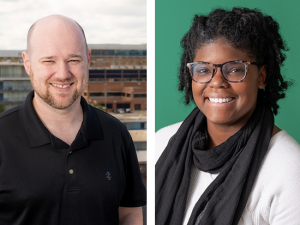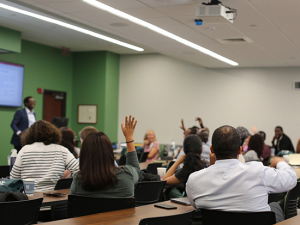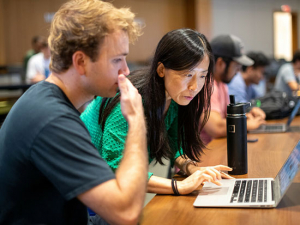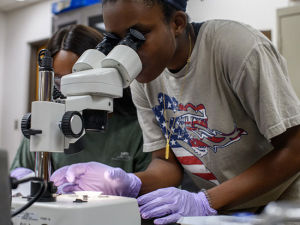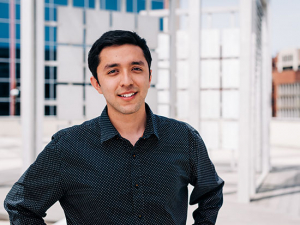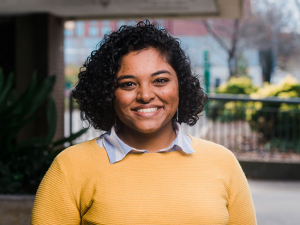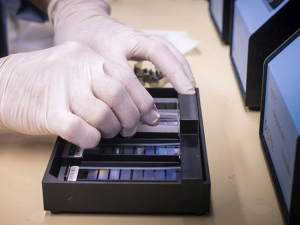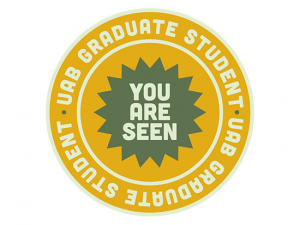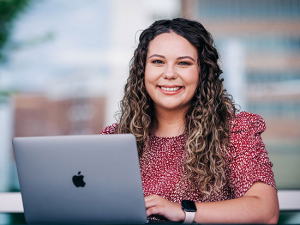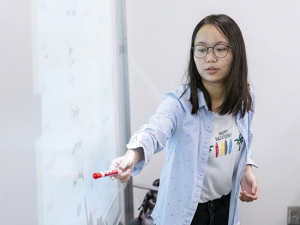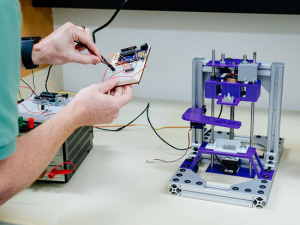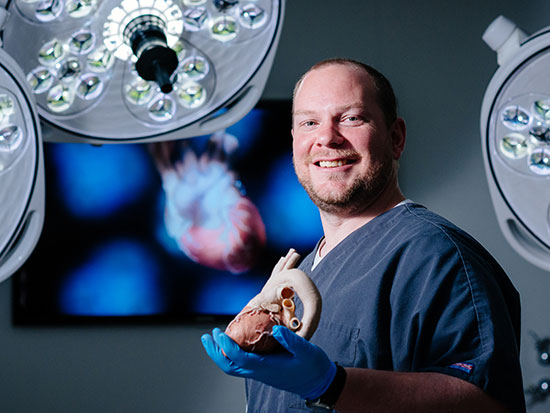 Where have all the anatomists gone? Scientific trends have sent the number of doctoral anatomy graduates to record lows, according to new research by William Brooks, Ph.D. But Brooks and other faculty in the anatomy master's degree program UAB launched this fall are helping students catch the wonder at the heart of the profession.An aging population and other demographic changes have raised concerns about the growing physician shortage in the United States. By 2032, according to a 2019 report from the Association of American Medical Colleges, the number of Americans age 65 and older will be nearly double what it is today. The overall population is projected to increase by 10 percent in that timeframe. Meanwhile, four in 10 currently active doctors will have reached retirement age within the next decade.
Where have all the anatomists gone? Scientific trends have sent the number of doctoral anatomy graduates to record lows, according to new research by William Brooks, Ph.D. But Brooks and other faculty in the anatomy master's degree program UAB launched this fall are helping students catch the wonder at the heart of the profession.An aging population and other demographic changes have raised concerns about the growing physician shortage in the United States. By 2032, according to a 2019 report from the Association of American Medical Colleges, the number of Americans age 65 and older will be nearly double what it is today. The overall population is projected to increase by 10 percent in that timeframe. Meanwhile, four in 10 currently active doctors will have reached retirement age within the next decade.
That data all adds up to a shortfall of primary care and specialty physicians that could reach 122,000 by 2032, the AAMC suggests. And it’s not just the doctors. Similar demographic and economic factors are driving demand for other health care professionals, including physical therapists, physician assistants and advanced practice nurses.
Health-education institutions are responding. Enrollments in U.S. medical schools increased from 77,370 in 2009 to 91,391 in 2018. (The UAB School of Medicine increased its class size from 176 to its current size of 186 students earlier this decade.) Meanwhile, new schools of medicine and new schools and programs in nursing and health professions are opening at a rapid rate. (In the past five years, 65 new physician assistant programs have been established, for example.)
But as they race to add bodies to meet the growing crisis, these schools are running into a roadblock: they can’t find enough people who know the body well enough to teach it to the next generation of health care providers.
Learn more about UAB's Master of Science in Anatomical Science program, which launched in 2019, in the video above.
No gross, no net
“We hear all the time about shortages of primary care physicians, but we’re not increasing the supply of educators needed to meet the training needs for these future doctors and nurses,” said William Brooks, Ph.D., associate professor in the Department of Cell, Developmental and Integrative Biology and director of the Gross Anatomy and Surgical Anatomy labs in the School of Medicine.
| “If you have a degree and the training, finding the job is easy.” |
“The anatomical sciences provide the underpinning for virtually all medical and allied health specialties as well as a number of non-medical disciplines such as anthropology and kinesiology,” Brooks and co-authors noted in a recent study, What Does a Modern Anatomist Look Like? Current Trends in the Training of Anatomy Educators, published this year in the journal Anatomical Sciences Education.
The problem has been a talking point in the literature for the past 17 years, Brooks and colleagues note in a separate article, A Look at the Anatomy Educator Job Market: Anatomists Remain in Short Supply. And yet, their survey of more than 130 department chairs in the United States, Canada and the European Union found that more than 65 percent anticipate they will have “moderate” to “great” difficulty in hiring the anatomy educators needed during the next five years.
In 2018, there were 52 job postings for anatomy educators at U.S. medical schools alone, more than double the previous year. Meanwhile, an average of only 17 doctoral degrees in anatomy were awarded each year between 2014 and 2017, Brooks and Adam Wilson, Ph.D., of Rush University, wrote in an article for the newsletter of the American Association of Anatomists. In fact, from a peak of more than 160 anatomy doctoral graduates in the early 1980s, the field hit a 50-year low in 2017, with only nine doctoral degrees awarded in the United States.
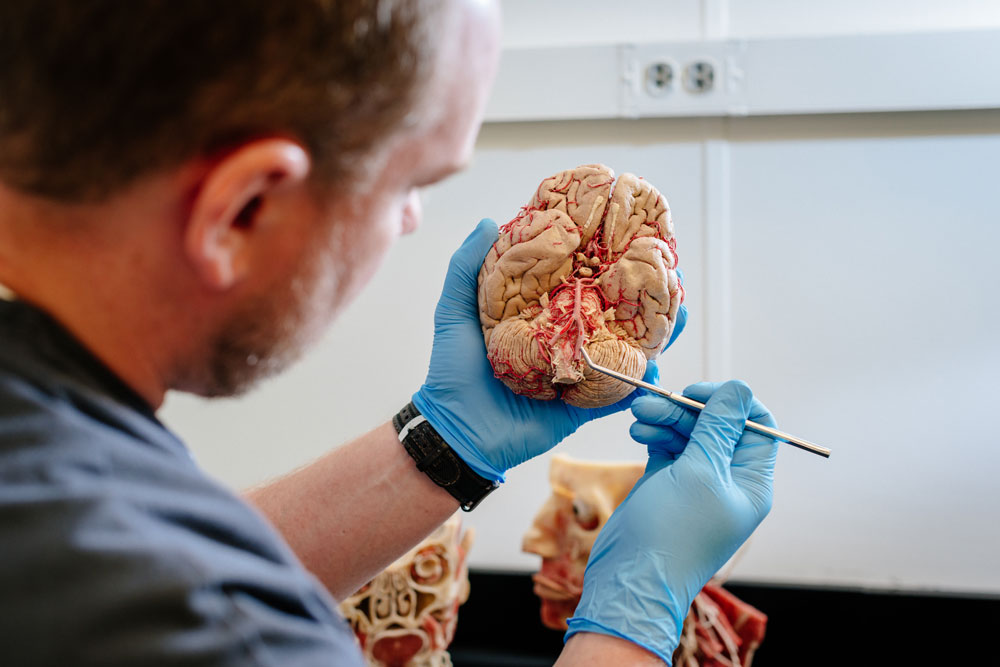 Brooks points out features in one of the program's "plastinated" models, produced by the same German company behind the blockbuster BODY WORLDS exhibition that visited Birmingham's McWane Center in 2016.
Brooks points out features in one of the program's "plastinated" models, produced by the same German company behind the blockbuster BODY WORLDS exhibition that visited Birmingham's McWane Center in 2016.
Wanted: body explorers
“If you have a degree and the training, finding the job is easy,” Brooks said. The trouble is, graduate-training programs in anatomy also are in short supply.
| “There really aren’t any other programs of this nature in the state and very few in the country. So if you not only want to be good at anatomy — but be good at teaching anatomy and learn how to do educational research — this is the only place you can do that." — Bradley Barger, Ph.D. assistant professor |
Anatomy professors with doctorates in anatomy once comprised the bulk of the field. But as biomedical research shifted its focus from the structural to the molecular throughout the late 20th century, graduate students who once took gross anatomy courses now take cell biology and genetics instead. That cut off a previous pipeline of anatomy doctorates, Brooks explained, and led many anatomy doctoral training programs to close. Unlike master’s programs, which are largely tuition-based, doctoral trainees in the United States usually are funded through grants held by their mentor’s lab. And anatomy research — though an active area of study — does not benefit from much in the way of grant dollars. (See Anatomy research: What are you looking for? below.)
In 2019, UAB launched a master’s degree program in anatomical science to help meet the growing need for anatomists. The program is co-directed by UAB anatomists David Resuehr, Ph.D. and Bradley Barger, Ph.D. Classes began in June, with all of the program’s five slots filled. The 15-month program is aimed primarily at students with master’s and doctoral degrees in STEM fields or clinical practitioners who want to have a greater focus on teaching, Brooks said. His recent research confirmed that these are the credentials that health programs are looking for. “We found that when chairs are looking for faculty to fill these positions, they are looking for Ph.D.s in anatomy education and Ph.D.s in the basic sciences,” Brooks said. “Those are the two degrees that we need to churn out trained educators.”
That mirrors Brooks’ own experience. He earned his doctorate in cell biology at UAB in 2007 but decided he loved teaching more than isolated bench work in his own lab. A faculty position at a smaller university that required him to teach anatomy opened his eyes to the charms of the field.
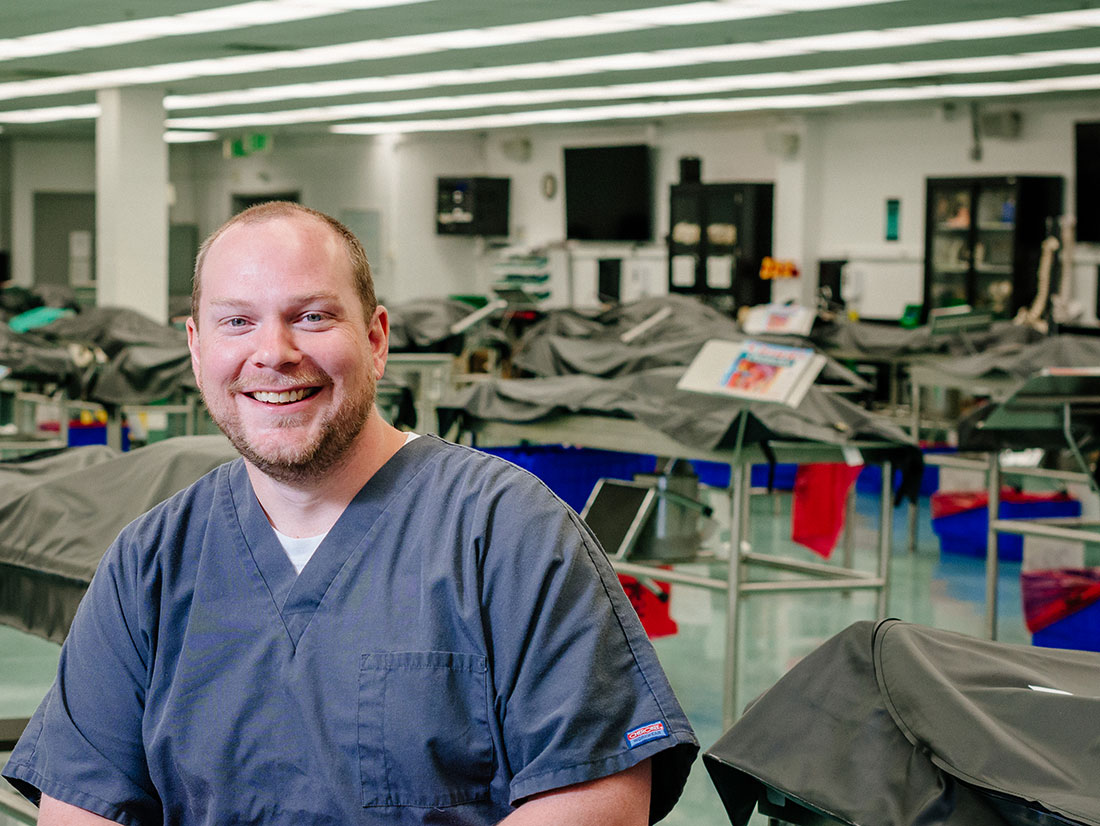 Brooks in UAB's Gross Anatomy Lab, where he trains students from the schools of Medicine, Nursing, Optometry, Dentistry and Health Professions, along with educators from colleges and high schools in summer workshops.
Brooks in UAB's Gross Anatomy Lab, where he trains students from the schools of Medicine, Nursing, Optometry, Dentistry and Health Professions, along with educators from colleges and high schools in summer workshops.
Seeing and feeling
“Anatomy is tangible, you see it and feel it and you are exploring the body firsthand,” Brooks said. “That is what drew me in. My background was all molecular-based, where you can’t ever really see what you are working on with your own eyes.”
UAB’s Master of Science in Anatomical Science program offers students training in the latest innovations in anatomy education, including 3D anatomy via ultrasound, plastic-impregnated human-tissue specimens and radiologic anatomy using CT scans. But it’s the UAB Gross Anatomy Lab, where students painstakingly dissect anatomical donors, that is the major draw, Brooks said. The lab is used by all medical, dental and optometry students and the physician assistant and physical therapy students in the School of Health Professions. It also supplies cadavers to the undergraduate anatomy program in the College of Arts and Sciences, where aspiring physician-scientists get hands-on experience as juniors and seniors.
“Some institutions are using technology to replace dissection, because running a cadaveric program can be costly, but we still believe that dissection is the gold standard,” Brooks said. “Being in the lab and exploring the body firsthand is irreplaceable. You quickly learn that every body is unique. In a room full of donor cadavers, students can appreciate that we’re all different. We can gather students around to see how structures vary from one person to another. When learning by computer-based instruction, you just have one representative anatomy. You lose that appreciation for diversity and variation as well as the appreciation for the layering of tissues that is really brought out through dissection.”
One other major advantage to the lab is “we can incorporate more humanism in our training,” Brooks said. “Death and dying are a reality of health care. Seeing and interacting with your first patient, who happens to be a deceased patient, is important for students to deal with.”
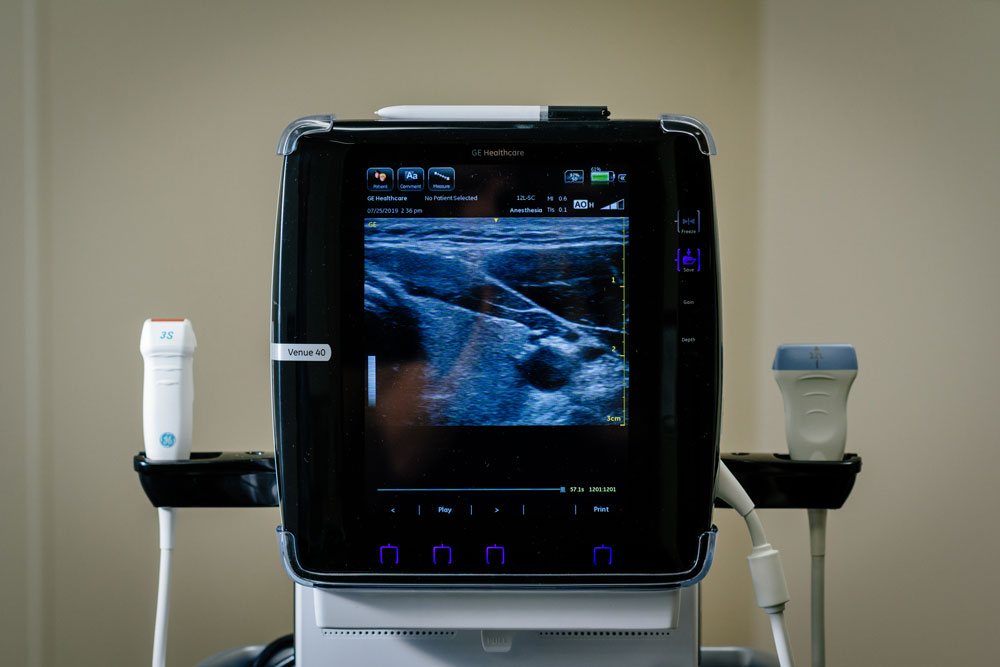 Closeup view of the throat courtesy of one of the portable ultrasound machines that the anatomy program uses in its training.
Closeup view of the throat courtesy of one of the portable ultrasound machines that the anatomy program uses in its training.
Technology has its place
That said, technology is going to become more and more prevalent in anatomy education, “so our master’s students who will end up teaching anatomy need to know how to use these tools effectively,” Brooks said. The latest tools are virtual reality programs, or experiences as they are known in the VR world. The new Virtual Reality Studio in UAB’s Lister Hill Library of the Health Sciences includes several anatomy-related experiences, including 3D Organon VR Anatomy, the Physiology of the Eye and Medicalholodeck.
“That’s one of the things we plan to incorporate in our instruction,” Brooks said. “But it always comes back to the question: How would you use this technology for teaching anatomy?”
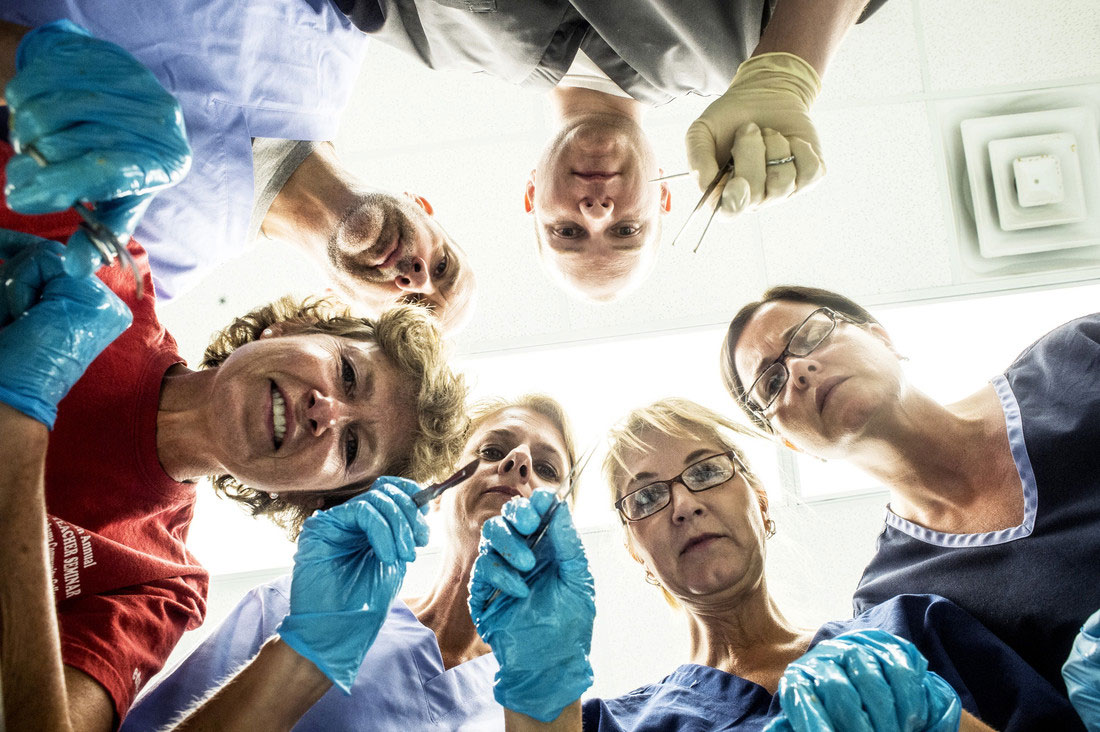 Brooks and students in one of his inaugural Gross Anatomy for Teacher Education workshops in 2014. The program attracts high school and undergraduate anatomy teachers. "Most of them have never done dissection," Brooks said. "This is a great experience for them."
Brooks and students in one of his inaugural Gross Anatomy for Teacher Education workshops in 2014. The program attracts high school and undergraduate anatomy teachers. "Most of them have never done dissection," Brooks said. "This is a great experience for them."
Anatomy research: What are you looking for?As part of their training, students in the UAB Master of Science in Anatomical Science program must develop a research topic in medical education or original anatomy. Original anatomy? “People think anatomy is static,” Brooks said. “Nothing’s changing in there, right?” Actually, anatomy research on cadavers is crucial to develop new ways to fix the body, he explained. “Surgeons want to know, which muscles can you use to repair a common injury site or what nerve can be used for grafting?” The need is particularly pressing for conditions with pronounced ethnic or gender differences. “What are the ideal ways of creating a new surgical approach?” Brooks said. “That’s what anatomy research can answer.” Back to story |
Summer bodies
Anatomy education at UAB isn’t just for current students. The GATE — Gross Anatomy for Teacher Education — workshop, which Brooks started in 2014, is a professional development course taught during the summer that attracts high school and undergraduate anatomy teachers. “Most of them have never done dissection,” Brooks said. “This is a great experience for them.” Faculty from community colleges and smaller liberal arts schools, which rarely have cadaveric dissection programs of their own, come to UAB for this three-day continuing-education course.
There are anatomy review courses for physical therapists and athletic trainers as well. “They have all taken anatomy but for most of them it’s been awhile,” Brooks said. “Now, they have been in practice for a number of years and have the clinical context to better appreciate the anatomy.
“We aim to offer training across the entire spectrum,” Brooks said. “College, graduate school and education throughout your career. We’re training educators at the graduate level and throughout their professional lives.”
As a researcher, Brooks says he will continue to explore the details of anatomy education issues in the United States and around the world. He is also a vocal advocate, on Twitter @willsambrooks and in the profession, for the expansion of anatomy-training programs.
“UAB can’t solve this problem on its own,” he said. “We want other universities to follow our lead and start their own programs.”
The armpit challengeThe axilla, which houses the brachial plexus, is hard to love. Especially when it goes by its common name — the armpit. (Calling something “the armpit of…” as in “the armpit of America,” is a deep insult.) So anatomist Will Brooks was going out on a limb when asked to name his favorite anatomical area on a recent episode of the Anatomy Education Podcast. “My favorite thing ever is the brachial plexus,” he told host James Pickering, Ph.D., of the University of Leeds School of Medicine. Pickering seemed surprised at the choice. “Someone’s got to, I suppose,” he deadpanned. “It’s complicated, and some people don’t like that,” Brooks said with a laugh, when asked recently to defend his choice. “It is highly complex because it innervates everything in the upper limb, but the complexity is what I find to be most intriguing. I enjoy teaching it because I like taking complex topics and breaking them down so that students can understand. I like to embrace the challenge.” |
